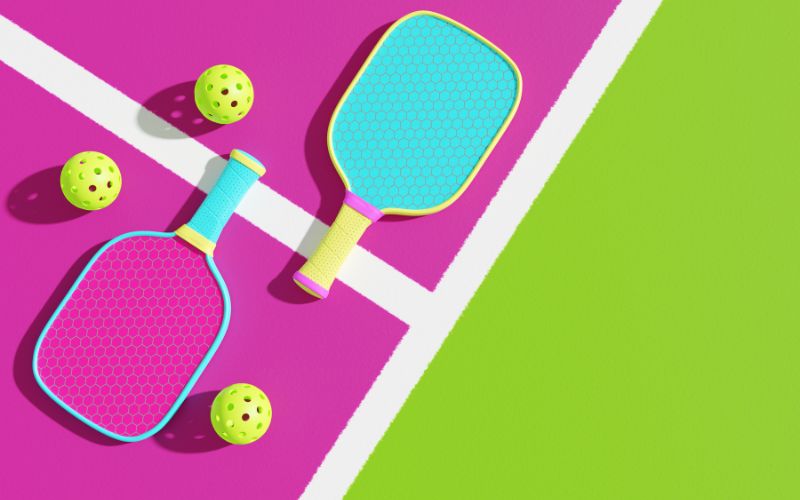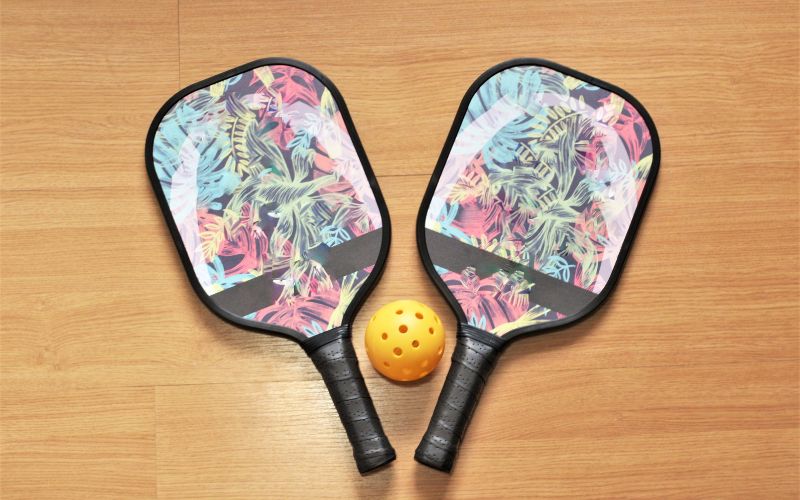Pickleball has surged in popularity over the years, attracting players from all walks of life, from beginners to seasoned athletes. One crucial aspect of optimizing your gameplay is selecting the right pickleball paddle. Among the myriad of factors to consider, paddle weight stands out as a critical element that can significantly impact your performance on the court.
In this comprehensive guide, we delve into the nuances of pickleball paddle weight, exploring how different weights affect your game, what to consider when choosing a paddle, and expert recommendations for finding the ideal weight for your playing style and skill level.
Understanding Paddle Weight
What Does Paddle Weight Refer To?
Paddle weight refers to the mass of the pickleball paddle, typically measured in ounces. It’s one of the key characteristics that players assess when selecting a paddle. Paddle weights can vary significantly, ranging from ultra-lightweight to heavier options.
Importance of Paddle Weight
The weight of your paddle directly influences various aspects of your gameplay, including power, control, maneuverability, and comfort. Choosing the right weight can enhance your performance and prevent fatigue during extended play sessions.
What is the significance of the weight of a pickleball paddle?
The weight of a pickleball paddle holds importance as it impacts various aspects of playing the sport. Paddle weight directly correlates with the force a player can apply to the ball, significantly influencing the speed of both the ball and paddle, as well as control. Moreover, it also affects the player’s arm strength and endurance over the course of a game.
Every component of the paddle contributes to its weight, including the edge guard, surface materials, handle length, and embellishments. Essentially, anything attached to the paddle adds to its overall weight.
Lightweight vs. Heavier Paddles: Pros and Cons
Lightweight Paddles
Lightweight paddles are favored by players seeking agility and maneuverability on the court. These paddles typically weigh between 6 to 8 ounces, offering swift reactions and easy handling.
Pros of Lightweight Paddles
- Maneuverability: Lightweight paddles enable quick movements, making them ideal for players who rely on agility and finesse.
- Reduced Fatigue: Lighter paddles can help prevent arm fatigue during extended matches, allowing players to maintain peak performance.
- Speed: Lightweight paddles facilitate rapid swings, enabling players to react swiftly to fast-paced rallies.
Cons of Lightweight Paddles
- Less Power: Lightweight paddles may sacrifice some power, requiring players to generate more force to execute powerful shots.
- Limited Control: Some players may find it challenging to maintain precise control over the ball with ultra-lightweight paddles, especially during intense exchanges.
Heavier Paddles
Heavier paddles, typically weighing between 8 to 14 ounces, offer distinct advantages for certain playing styles and preferences.
Pros of Heavier Paddles
- Power: Heavier paddles naturally generate more power, allowing players to execute authoritative shots with minimal effort.
- Stability: The additional weight provides stability and solidity, particularly beneficial for players who prioritize control and accuracy.
- Durable: Heavier paddles are often more robust and durable, capable of withstanding intense gameplay and frequent use.
Cons of Heavier Paddles
- Reduced Maneuverability: Heavier paddles may feel cumbersome and sluggish, limiting players’ ability to react quickly to rapid exchanges.
- Fatigue: Prolonged use of a heavy paddle can lead to arm fatigue and strain, affecting players’ endurance over extended matches.
3 Distinct Weight Classes
Pickleball paddles are categorized into three distinct weight classes based on their mass:
- Lightweight Paddles: These paddles weigh below 7.3 ounces. They are favored by players who prioritize agility and maneuverability on the court. Lightweight paddles enable swift reactions and ease of handling, making them suitable for players who rely on quick movements and finesse to outmaneuver opponents.
- Midweight Paddles: Falling within the range of 7.3 ounces to 8.3 ounces, midweight paddles strike a balance between power and control. They offer stability and solidity, allowing players to execute powerful shots with precision while maintaining maneuverability. Midweight paddles are a popular choice among players seeking versatility and adaptability in their gameplay.
- Heavy Paddles: Weighing above 8.3 ounces, heavy paddles are characterized by their robustness and durability. These paddles generate significant power behind each shot, making them suitable for players who prioritize authoritative strokes and stability. While heavy paddles may sacrifice some agility, they compensate by offering enhanced control and the ability to absorb and redirect incoming shots effectively.
Finding Your Ideal Paddle Weight
Consider Your Playing Style
Your playing style plays a crucial role in determining the most suitable paddle weight for your needs. Consider whether you prioritize power and control, rely on agility and speed, or seek a balanced approach that combines both elements.
Assess Your Skill Level
Novice players and those new to pickleball may benefit from starting with a lighter paddle to focus on technique and maneuverability. As your skills progress, you can experiment with heavier paddles to harness additional power and control.
Seek Expert Advice
Consulting with experienced players, coaches, or paddle specialists can provide valuable insights into selecting the optimal paddle weight. They can offer personalized recommendations based on your playing style, skill level, and performance objectives.
Expert Insights and Recommendations
Revolin Sports
According to Revolin Sports’ Pickleball Paddle Weight Guide, players should consider a paddle’s weight range based on their preferences and playing style. Lightweight paddles are recommended for players seeking agility and finesse, while midweight options offer a balance of power and control. Heavier paddles are suggested for players who prioritize stability and authoritative shots.
Paddletek
Paddletek’s Pickleball Paddle Weight article highlights the significance of paddle weight in optimizing performance. The article emphasizes the importance of selecting a paddle that complements your playing style and skill level, whether you prefer a lightweight, midweight, or heavier option.
Conclusion
In the dynamic world of pickleball, the weight of your paddle can make all the difference in your gameplay experience. By understanding the nuances of pickleball paddle weight and considering factors such as playing style, skill level, and expert recommendations, you can make an informed decision that enhances your performance on the court. Whether you opt for a lightweight paddle for agility or a heavier paddle for power and control, finding the perfect balance ensures you’re equipped to take on every rally with confidence and precision.
FAQs for “Pickleball Paddle Weight Guide: Finding the Perfect Balance for Your Game”
1. What Does Paddle Weight Refer To?
Paddle weight refers to the mass of the pickleball paddle, typically measured in ounces. It’s one of the key characteristics that players assess when selecting a paddle. Paddle weights can vary significantly, ranging from ultra-lightweight to heavier options.
2. What is the significance of the weight of a pickleball paddle?
The weight of a pickleball paddle holds importance as it impacts various aspects of playing the sport. Paddle weight directly correlates with the force a player can apply to the ball, significantly influencing the speed of both the ball and paddle, as well as control. Moreover, it also affects the player’s arm strength and endurance over the course of a game.
3. Lightweight vs. Heavier Paddles: Pros and Cons
- Lightweight Paddles: These paddles offer agility and maneuverability, facilitating quick movements and reducing arm fatigue during extended matches. However, they may sacrifice some power and control.
- Heavier Paddles: Heavier paddles provide more power and stability, ideal for players seeking authoritative shots and durability. Yet, they may feel cumbersome and lead to fatigue over time.
4. What are the 3 Distinct Weight Classes of Pickleball Paddles?
Pickleball paddles are categorized into three distinct weight classes based on their mass:
- Lightweight Paddles: Below 7.3 ounces, favored for agility and maneuverability.
- Midweight Paddles: Between 7.3 to 8.3 ounces, offering a balance of power and control.
- Heavy Paddles: Above 8.3 ounces, characterized by robustness and power.
5. How Can I Find My Ideal Paddle Weight?
- Consider Your Playing Style: Determine whether you prioritize power, control, agility, or a balance of these factors.
- Assess Your Skill Level: Beginners may start with lighter paddles to focus on technique, while experienced players may experiment with heavier options.
- Seek Expert Advice: Consult with experienced players, coaches, or paddle specialists for personalized recommendations based on your preferences and performance goals.






